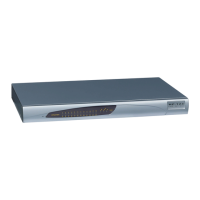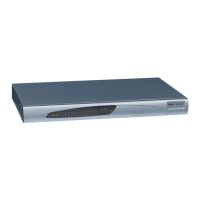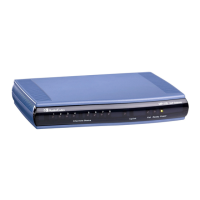Version 6.6 119 MP-11x & MP-124
User's Manual 11. Network
Common routing rule configuration errors may include the following:
The IP address specified in the 'Gateway IP Address' field is unreachable from the
interface specified in the 'Interface Name' field.
The same destination is configured in two different routing rules.
More than 30 routing rules have been configured.
Note: If an IP routing rule is required to access OAMP applications (for remote
management, for example) and the route is not configured correctly, the route
is not added and the device is not accessible remotely. To restore
connectivity, the device must be accessed locally from the OAMP subnet and
the required routes be configured.
11.4 Configuring Quality of Service
The QoS Settings page is used for configuring the Layer-2 and Layer-3 Quality of Service
(QoS) parameters. Differentiated Services (DiffServ) is an architecture providing different
types or levels of service for IP traffic. DiffServ (according to RFC 2474), prioritizes certain
traffic types based on their priority, thereby, accomplishing a higher-level QoS at the
expense of other traffic types. By prioritizing packets, DiffServ routers can minimize
transmission delays for time-sensitive packets such as VoIP packets.
You can assign different VLAN priorities (IEEE 802.1p) and DiffServ to the supported Class
of Service (CoS):
Network Service class – network control traffic (ICMP, ARP)
Premium Media service class – used for RTP media traffic
Premium Control service class – used for call control (i.e., SIP) traffic
Gold service class – used for streaming applications
Bronze service class – used for OAMP applications
The Layer-2 QoS parameters define the values for the 3 priority bits in the VLAN tag of
frames related to a specific service class (according to the IEEE 802.1p standard). The
Layer-3 QoS parameters define the values of the DiffServ field in the IP Header of the
frames related to a specific service class.
The mapping of an application to its CoS and traffic type is shown in the table below:
Table 11-13: Traffic/Network Types and Priority
Application Traffic / Network Types Class-of-Service (Priority)
Debugging interface
Management Bronze
Telnet
Management Bronze
DHCP
Management Network
Web server (HTTP)
Management Bronze
SNMP GET/SET
Management Bronze
Web server (HTTPS)
Management Bronze
IPSec IKE
Determined by the service Determined by the service
RTP traffic
Media Premium media
RTCP traffic
Media Premium media

